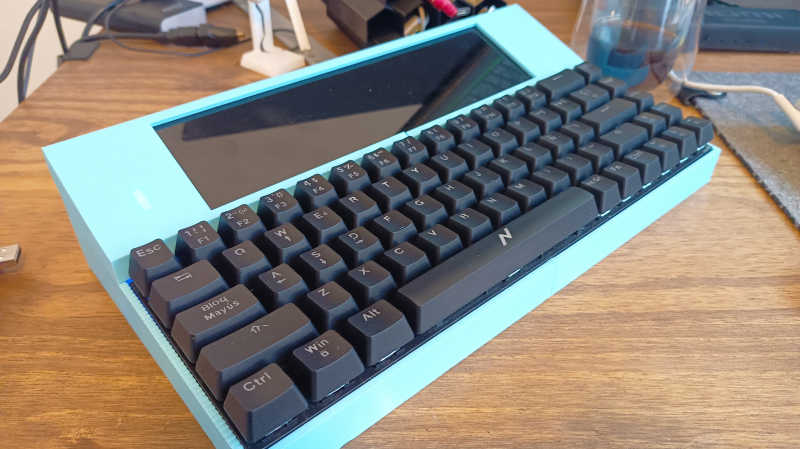The TRS-80 Model 100 was a strange beast. When it debuted in 1983, it resembled nothing that was available at the time, and filled a gap between desktop computers and the mostly-not-invented-yet laptop segment of the market. Collectors covet these machines, but they’re getting harder to find four decades later. So, if you want one, you just might have to roll your own.
Honestly, it doesn’t appear [Roberto Alsina]’s purpose here we to recreate the Model 100 per se, but rather to take inspiration from its oddball form factor and experiment with the latest components. The design elements from the original that [Roberto]’s creation most strongly echo are the screen with the extreme landscape aspect ratio and the somewhat compressed keyboard. The latter is based on the cheapest mechanical 65% keyboard available, while the former is a 1920×480 LCD display intended for automotive applications. The display seems like it put up a fight, between its need for a custom HDMI cable to connect it to the Radxa Zero SBC under the hood as well as the custom kernel needed to support it.
Along with a USB hub for IO and some 18650s for power, everything went into a 3D printed case with considerably sleeker lines than the Model 100. It’s worth pointing out that [Roberto] didn’t have much experience with design or 3D printing when he kicked off this project. We love to see people stretching their skills like that, and we think the results are great in this case. We’ve seen a lot of Model 100 retrofits and brain transplants, but this may be the first time we’ve seen a build quite like this.















i worked computer support at a newspaper and we bought 6-8 of these, mostly for the sportswriters to file stories back from the stadiums on friday night after the high school football games. they were very rugged and actually easy to get into and repair which was good because sportswriters threw them around like footballs.
the weak link of course were the accoustic modems which were using really lousy and noisy phone lines at those stadiums. when the mod 200 came out we bought about 4 of those as well, but by that time ‘real’ laptops were appearing. i still love the model 100s and to this day i’ve rarely found a better keyboard to type on, laptop or desktop. /guy
This is a great Tandy 100/Cambridge Z88 update. I would rounding the edges of the case a little bit to get ride of the hard edges. I was thinking of doing something like this myself. Now just run a Model 100 or Z88 emulator :) Good project. I give it three thumbs up.
I have it running virtualt which emulates the model 100 but the UI is kinda broken :-)
Considering he produced the model using a Python program (no, I still won’t call Python programs “scripts”,) so I think that rounding those edges would have been a major undertaking. Still, the time might have been better spent learning OpenSCAD or FreeCAD.
No, it’s like two lines of code, one to select the edges, one to fillet them.
In fact, the only square edges are the ones in the bottom and the two in the back corners.
But can it run on AA batteries?
He claims 3-5 hours out of a pair of 18650s. So call it 20 watt-hours over 4 hours = 5 watts.
Four fresh alkaline AA batteries (what the Model 100 uses) can supply 5 watts for less than an hour.
A freshly-charged new set of high-capacity NiMH might hit 2 hours.
Considering it was approximately equal to the Apple ][ in computing power, the Model 100 was pretty darned good for battery life.
> The TRS-80 Model 100 was a strange beast. When it debuted in 1983, it resembled nothing that was available at the time
Not quite nothing; the Epson HX20 was released a year earlier, and conceived another two years before that. The Kyocera laptops were (debatably) more practical than the HX20, but there’s a definite resemblance between them.
Good catch, you just beat me to it. And the HX-20 (like its cousin, the PX-8) had something that the TRS-80 lacked: a built-in microcassette deck for storing programs and data.
I am really tempted to do a PX-8 style top case while keeping the bottom case the same, that way it can be converted from one to the other in a couple of minutes.
Also doing hinges should be fun :-)
nice but fat, too fat
When you insist on “mechanical” keyboards (what does that mean, anyway; every keyboard I’ve ever used had moving keys), that dominates the thickness, and also gives you lots of room in the non-keyboard part of your design.
One of the most astonishing things about the last decade or so is how we’ve ended up in a situation where most of us willingly put hours a day in on keyboards with all the ergonomics of the ZX81. Only smaller.
I see you never used a ZX-81 :-)
That was for BrightBlueJim, not “just passing”, of course.
ZX81 keys don’t move. The keyboard is literally a sticker.
It’s fatter than a **closed** regular notebook but much thinner than an **open** regular notebook. You can’t really use a **closed** notebook, can you? ;-)
Bought the same exact 1920×480 screen way back for this same exact purpose, by the lazy boy in me just let it sit under my main monitor as a secondary screen for chats, and some text-based applications.
Seems more like Olivetti M10 than TRS-80 model 100
https://it.wikipedia.org/wiki/Olivetti_M10
They are all basically Kyocera KC85s :-)
Must confess I had never seen the M10, but yeah, it looks a lot like it!